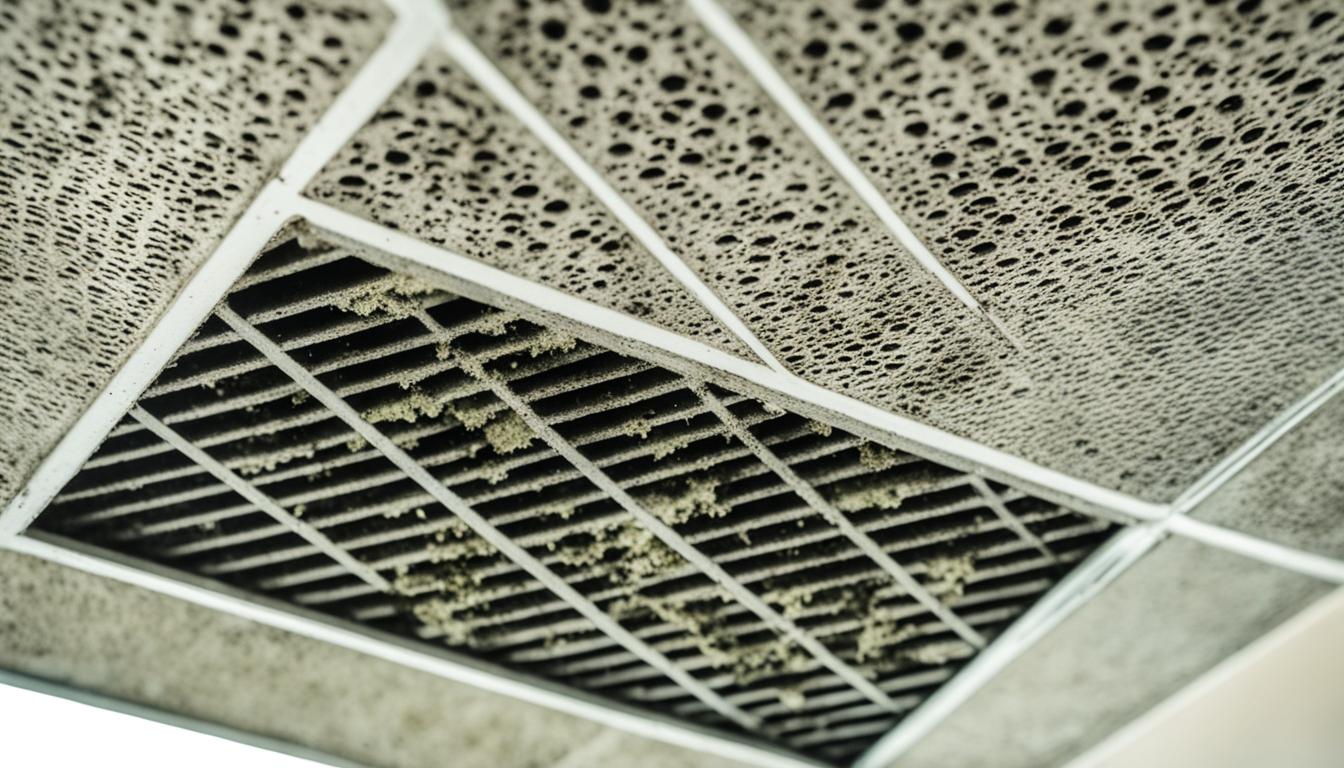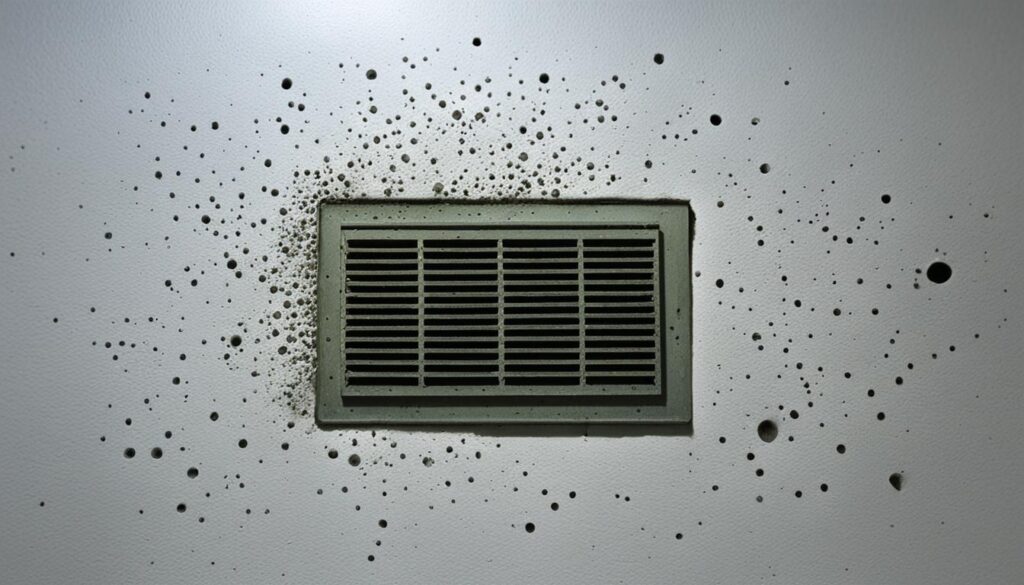
Eliminate Mold from Carpet: Proven Removal Guide
Welcome to our comprehensive guide on how to remove mold from carpet and improve the air quality in your home. If you’ve noticed mold growth in your air vents, it’s crucial to address this issue promptly to ensure a healthy environment for you and your family. Mold in air vents can negatively impact air circulation and cause various health risks. By following the proven removal methods and tips we’ll discuss in this article, you’ll be able to eliminate mold effectively and breathe easier once again.
Key Takeaways
- Identify and address mold growth in air vents to improve air quality.
- Mold in air vents can lead to poor air circulation and health risks.
- Explore professional and DIY methods to remove mold from air vents.
- Follow step-by-step guidance to ensure thorough mold removal.
- Contact Fix Mold Miami at 305-465-6653 for professional mold assessment and remediation.
Understanding Mold in Air Vents
If you suspect mold growth in your home, it’s essential to pay attention to your HVAC system. Mold in air vents can pose significant health risks and impact air circulation throughout your living space. By understanding the causes, signs, and potential consequences of mold growth in air vents, you’ll be better equipped to address and eliminate the problem.
The Causes of Mold Growth in Air Vents
Mold thrives in environments with high moisture levels. Your HVAC system provides an ideal breeding ground for mold spores due to the presence of condensation and stagnant air. Factors that contribute to mold growth in air vents include:
- Poor ventilation
- Humid climates
- Water leaks or infiltration
- Inadequate insulation
When moisture accumulates in the air vents, it creates a conducive environment for mold to grow and spread. If left untreated, the mold can infiltrate your entire home, leading to more extensive damage and health issues.
Recognizing the Signs of Mold in Air Vents
Identifying mold growth in your air vents is crucial for early intervention. Look out for the following signs:
- Visible mold growth around the vents
- A musty odor coming from the vents
- Allergic reactions, such as sneezing, coughing, or watery eyes
- Worsening respiratory symptoms
If you notice any of these signs, it’s important to take immediate action to prevent the mold from spreading further and affecting your indoor air quality.
Potential Health Risks Associated with Mold Exposure
Exposure to mold can have detrimental effects on your health, especially for individuals with respiratory conditions, allergies, or weakened immune systems. Some potential health risks of mold exposure include:
- Respiratory issues, such as coughing, wheezing, and shortness of breath
- Allergic reactions, including skin rashes and nasal congestion
- Headaches and fatigue
- Exacerbation of asthma symptoms
It’s important to note that prolonged exposure to mold can worsen these symptoms and lead to more severe health complications. Taking prompt action to eliminate mold growth in your air vents is crucial for maintaining a healthy living environment.
“Mold in air vents can significantly impact air quality and pose health risks. By understanding the causes, signs, and potential consequences of mold growth in air vents, you can address the problem effectively and protect your well-being.”

| Effects of Mold in Air Vents | Health Risks | Prevention Tips |
|---|---|---|
| Poor air circulation | Respiratory issues | Regular maintenance of HVAC system |
| Unpleasant odors | Allergic reactions | Monitor humidity levels |
| Spread of mold spores | Headaches and fatigue | Fix water leaks promptly |
Removing Mold from Air Vents
In this section, we will explore various methods to safely and effectively remove mold from air vents. Whether you prefer professional assistance or prefer the do-it-yourself (DIY) approach, we’ve got you covered. By following our step-by-step guidance, you can eliminate mold and ensure a clean and healthy living environment.
Professional Mold Removal
If you’re dealing with a severe mold infestation or have limited experience with mold removal, seeking professional assistance is highly recommended. Professional mold removal experts have the knowledge, experience, and specialized equipment to handle even the most challenging mold issues.
“Engaging professional mold removal services ensures a thorough and efficient removal process, giving you peace of mind.” – Mike Johnson, Mold Remediation Expert.
When opting for professional assistance, consider hiring a reputable mold remediation company. They will conduct a comprehensive assessment of the mold situation, develop a tailored removal plan, and execute the removal process in a safe and efficient manner.
DIY Mold Removal Solutions
If the mold growth in your air vents is relatively minor and you feel confident in taking on the task yourself, DIY solutions can be an effective option. However, it’s crucial to prioritize your safety by wearing appropriate protective gear, such as gloves, goggles, and a mask, to minimize exposure to mold spores.
Here are some proven strategies for DIY mold removal:
- Inspect the vents: Begin by visually inspecting the air vents and identifying any visible signs of mold growth. This includes black or greenish patches, a musty odor, or a persistent cough or allergy symptoms when the HVAC system is running.
- Gather supplies: Equip yourself with the necessary tools, including a vacuum cleaner with a HEPA filter, a stiff-bristled brush, a mild detergent or mold cleaner, and a disinfectant.
- Disconnect the power: Before starting the cleaning process, switch off the HVAC system and disconnect the power supply to avoid any accidents or damage.
- Vacuum the vents: Use the vacuum cleaner with a HEPA filter to remove loose mold spores and debris from the vent surfaces.
- Clean with detergent or mold cleaner: Prepare a solution of mild detergent or specialized mold cleaner and water. Apply the solution to a stiff-bristled brush and scrub the vents thoroughly. Rinse with clean water.
- Disinfect the vents: To eliminate any remaining mold spores, spray a disinfectant approved for use on HVAC systems directly into the vents and let it sit for the recommended time.
- Dry and reassemble: Allow the air vents to dry completely before reassembling and turning the HVAC system back on.
Remember that while these DIY solutions can be effective for minor cases of mold growth, it’s crucial to monitor the situation closely. If the mold returns or persists, it’s advisable to consult a professional mold remediation service for a thorough assessment and comprehensive removal.

By implementing these mold removal methods, whether through professional assistance or DIY solutions, you can ensure a mold-free environment and improve the air quality in your home. The key is to take swift action and prioritize the health and well-being of you and your loved ones.
Conclusion
Eliminating mold from air vents is crucial for improving air quality and safeguarding your health. The presence of mold not only compromises the air circulation in your home but also poses potential health risks. By understanding the causes and signs of mold growth in air vents, you can take proactive steps to address the problem effectively.
In this article, we discussed various methods to remove mold from air vents, including both do-it-yourself solutions and professional assistance. It is essential to approach mold removal with caution and follow the recommended steps to ensure a thorough and safe process. Remember, prompt action is key to preventing further damage and maintaining a mold-free environment.
If you are facing persistent mold issues in your air vents, consider reaching out to Fix Mold Miami, Florida’s Highest Rated In Mold Assessments, Prevention, and Remediation service. Their expert team specializes in mold assessment, prevention, and remediation, providing comprehensive solutions for a safe and healthy living space. Contact Fix Mold Miami at 305-465-6653 to schedule a professional mold assessment and say goodbye to mold-related concerns.




